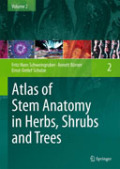
Atlas of stem anatomy in herbs, shrubs and trees v. 2
Schweingruber, Fritz Hans
Börner, Annett
Schulze, Ernst-Detlef
This work, published in two volumes, contains descriptions of the wood and bark anatomies of 3000 dicotyledonous plants of 120 families, highlighting the anatomical and phylogenetic diversity of dicotyledonous plants of the Northern Hemisphere. The first volume principally treats families of the Early Angiosperms, Eudicots, Core Eudicots and Rosids, while the second concentrates on the Asterids. .Presented in Volume 2 are microsections of the xylem and phloem of herbs, shrubs and trees of 1000 species and ca. 35 families of various life forms of the temperate zone along altitudinal gradients from the lowland at the Mediterranean coast to the alpine zone in Western Europe. Special attention isgiven to the very diverse family of Asteraceae. The global perspective of thefindings is underlined by the analysis of 400 species from the Caucasus, the Rocky Mountains and Andes, the subtropical zone on the Canary Islands, the arid zones in the Sahara, in Eurasia, Arabia and Southwest North America, New Zealand and the boreal and arctic zones in Eurasia and Canada. .The presence of annual rings in all life forms demonstrates that herbs and dwarf shrubs are an excellent tool for the reconstruction of annual biomass production and the interannual dynamic of plant associations. The common principle of the anatomicalexpression of secondary growth is a key factor in understanding evolution andadaptation processes in all life forms, from the 3 cm tall crepide pigmea (Crepis pygmaea) in the alpine zone to the 40 m tall ash (Fraxinus excelsior) in Central European riparian forests. The study opens vast fields of research fordendrochronology, wood anatomy, taxonomy and ecology.
- ISBN: 978-3-642-20434-0
- Editorial: Springer
- Encuadernacion: Cartoné
- Fecha Publicación: 31/08/2012
- Nº Volúmenes: 1
- Idioma: Inglés
